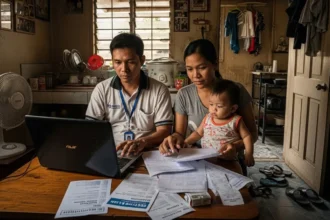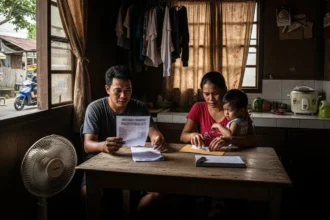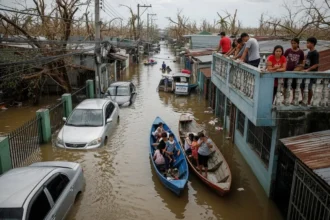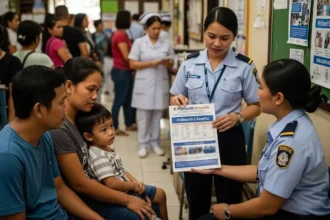It’s 2025, and buhay mahal has never felt this real. Every trip to the palengke or grocery feels like a small heartbreak – the same ₱1,000 that once filled a bayong now barely covers rice, ulam, and a few household staples. Prices rise quietly, but steadily. You see it in the thinner cuts of meat, the smaller shampoo sachets, the fewer pieces in your kids’ baon snacks.
- 💔 The Invisible Thief: Why Our Money Feels Worth Less
- 💰 Understanding the Beast: What Causes Inflation and Why It Hits Pinoys Hard
- 🍳 The Battle for Essentials: How Inflation Is Changing the Way We Eat, Commute, and Live
- 🧾 Diskarte 101: How Pinoy Families Are Fighting Back Against Inflation
- 📉 The Bigger Picture: What Inflation Means for the Future of Filipino Families (and How We Can Adapt)
- ❓ Frequently Asked Questions About Coping With Inflation in the Philippines
- 🌅 When Life Gets Pricier, We Get Wiser
- 🧭 References
This is the face of inflation in the Philippines 2025 – invisible but everywhere. It creeps into jeepney fares, electricity bills, even your morning coffee. It’s not just numbers on the news; it’s the sighs of parents comparing brands, the extra shift someone takes just to keep the fridge running.
Yet, amid all that, the Filipino spirit does what it always does – it adjusts, hustles, and finds ways to smile through it. From creative budgeting to side hustles and shared meals, families are learning how to survive (and even thrive) in this new economic reality.
So let’s talk about what buhay mahal really means today – not just in pesos and centavos, but in the daily diskarte, grit, and grace of the Pinoy coping with inflation.
💔 The Invisible Thief: Why Our Money Feels Worth Less
Every Filipino has met the invisible thief – the one that sneaks into your wallet without taking a single bill. You still earn the same salary, but somehow, your money doesn’t stretch like it used to. That thief’s name? Inflation.
In simple terms, inflation means the cost of goods and services goes up, while the value of your peso goes down. A kilo of rice that cost ₱40 two years ago might now be ₱60 or even ₱70 – same rice, same brand, just heavier on the budget. And it’s not just food. Electricity, LPG, jeepney fares, rent, even tuition – all climbing together, faster than most paychecks.
As of 2025, the inflation rate in the Philippines hovers around 4–5%, but the real impact feels bigger. Why? Because low-income and middle-class families spend most of their earnings on essentials – food, transportation, and utilities – which are the very items rising the fastest.
| Everyday Item | 2023 Price | 2025 Price (Average) | % Increase |
|---|---|---|---|
| Rice (per kilo) | ₱44 | ₱64 | +45% |
| Diesel (per liter) | ₱63 | ₱78 | +24% |
| LPG (11kg tank) | ₱900 | ₱1,200 | +33% |
| Tilapia (per kilo) | ₱140 | ₱190 | +36% |
| Electric Bill (avg.) | ₱3,500 | ₱4,500 | +28% |
You don’t need a degree in economics to feel it – ramdam mo na agad sa grocery cart pa lang.
The cost of living in the Philippines has risen faster than most household incomes, forcing families to adjust priorities. Suddenly, the budget for milk becomes the gas fund. A planned family outing turns into a “staycation” at home. Even birthdays and holidays are simplified – but still celebrated, because that’s just how we do it.
Inflation may be the invisible thief, but awareness is our first defense. Once we understand why our money feels smaller, we can start finding ways to make it work harder – Filipino style.
💰 Understanding the Beast: What Causes Inflation and Why It Hits Pinoys Hard
Inflation isn’t magic – it has causes. But for most of us, it feels like a bad dream that won’t end: bakit nga ba parang lahat sabay-sabay tumaas?
Here’s the truth: there’s no single villain. It’s a mix of global, national, and everyday Pinoy factors that make our wallets cry a little louder each year.
🌎 1. The Global Domino Effect
When oil prices rise abroad, everything in the Philippines follows – because fuel powers our transport, factories, and even farms.
- When the Middle East tightens supply, diesel here jumps by ₱3–₱5 per liter.
- That hike makes deliveries pricier, which then pushes up grocery and palengke prices.
It’s a domino effect that starts oceans away but lands straight in our kitchen.
🇵🇭 2. Local Supply Shortages
We also rely heavily on imported food – wheat, sugar, onions, rice, and even salt. When local harvests fail due to typhoons or pests, prices skyrocket.
Remember the onion crisis and rice import delays? Those weren’t isolated – they’re signs of how fragile our food system still is.
💱 3. The Weak Peso and Imports
When the peso weakens against the dollar, imported goods (like fuel, machinery, and even gadgets) become more expensive.
Example: If the dollar moves from ₱55 to ₱58, every imported product – from your shampoo to your laptop – quietly becomes pricier, even if it’s made in the same factory.
🏛️ 4. Policies, Taxes, and Red Tape
Sometimes, government policies meant to help – like import limits or excise taxes – can unintentionally add pressure. Add to that slow supply chains and corruption in logistics, and prices climb before anyone can stop them.
| Cause of Inflation | Real-Life Example | Effect on Pinoys |
|---|---|---|
| Rising oil prices | Diesel +₱5/L | Higher transport & delivery cost |
| Crop failure | Typhoon-damaged rice farms | Food scarcity, higher prices |
| Weak peso | ₱58 per USD | Imported goods more expensive |
| High taxes | Sugar & fuel excise taxes | Chain reaction in grocery prices |
💔 Why It Hurts the Most for Pinoys
Because we’re already budgeting to the last peso. For many, 70–80% of monthly income goes straight to food, rent, and utilities. When prices rise even 5%, there’s almost nothing left for savings or emergencies.
So when we talk about inflation in the Philippines, it’s not just about economics – it’s about the human cost: the quiet sacrifices, the skipped meals, and the resilience behind every “kaya pa ’to.”
🍳 The Battle for Essentials: How Inflation Is Changing the Way We Eat, Commute, and Live
Inflation doesn’t always look dramatic – it shows up in the little things. A smaller scoop of ulam. A thinner cut of pork. A jeepney driver waiting for one more passenger para “bawi sa diesel.” It’s the daily diskarte that tells the real story of how Filipinos are coping with inflation.
🍚 Food: The Shrinking Plate
Food prices hit hardest because that’s where most of our budget goes. Families are downshifting meals – less meat, more rice, and cheaper substitutes like eggs or sardines.
Many households stretch meals by cooking adobo or tinola that lasts for two days, or switching to cheaper cuts like buto-buto instead of liempo.
| Food Item | 2023 Price | 2025 Price | Pinoy Adjustment |
|---|---|---|---|
| Pork Liempo (per kilo) | ₱350 | ₱440 | Switch to chicken or eggs |
| Rice (per kilo) | ₱44 | ₱64 | Buy “broken rice” or mix varieties |
| Canned Sardines | ₱22 | ₱30 | Buy by the case, bulk savings |
| Instant Coffee | ₱10 | ₱15 | Shift to 3-in-1 sachets or brewed refills |
| Onion (per kilo) | ₱180 | ₱240 | Use less, mix with spring onions |
Even middle-class households now track grocery receipts down to the centavo. Meanwhile, low-income families rely on tingi-tingi and suki discounts to make ends meet.
🚗 Transport: The Cost of Movement
Commuters feel it too. Diesel price hikes push jeepney and tricycle fares up, eating into daily baon. What used to be a ₱40 roundtrip now costs ₱60–₱80. Many workers walk part of the way home or carpool with officemates.
Others shift to bicycles or e-scooters – not just for fitness, but as a survival move.
| Mode | 2023 Cost (Daily) | 2025 Cost | Common Adjustment |
|---|---|---|---|
| Jeepney (Roundtrip) | ₱40 | ₱60 | Combine routes, walk halfway |
| Bus (City Route) | ₱70 | ₱95 | Take earlier trips, fewer rides |
| Private Car (Fuel) | ₱900/week | ₱1,200 | Carpool with coworkers |
💡 Utilities and Everyday Living
The cost of living in the Philippines keeps rising quietly – electricity, LPG, and water rates all creeping up. People adapt by unplugging appliances more often, using rechargeable fans, or scheduling laundry on “low electric load” days.
Even small comforts are now luxuries – eating out becomes a birthday-only thing, and many families turn movie nights at home into the new mall date. But despite the belt-tightening, Pinoys still find joy in small things – a shared meal, a good laugh, a rainy afternoon with kape at tinapay.
Inflation may be testing the budget, but it hasn’t broken the bayanihan spirit. If anything, it’s teaching every Filipino the art of endurance – and creativity.
🧾 Diskarte 101: How Pinoy Families Are Fighting Back Against Inflation
When prices rise faster than paychecks, the Filipino spirit doesn’t break – it adjusts. Across the country, families are turning to tried-and-tested diskarte moves to stretch every peso and still live decently.
🏠 1. The 50-30-20 Budget Rule (Pinoy Edition)
It’s a classic budgeting formula – 50% for needs, 30% for wants, 20% for savings – but let’s be real, not everyone can follow it to the letter.
Pinoys tweak it: 60-25-15 or even 70-20-10, depending on income. What matters is consistency – setting aside kahit maliit for savings or emergencies.
💡 Budget Hack: Use envelopes or digital “wallets” for each expense. GCash, Maya, or even old-school coin jars work wonders for tracking spending.
| Category | Traditional Rule | Adjusted Pinoy Version | Example |
|---|---|---|---|
| Needs | 50% | 60–70% | Food, rent, transport |
| Wants | 30% | 20–25% | Netflix, small treats |
| Savings | 20% | 10–15% | Emergency fund, tuition |
💼 2. Side Hustles and Online Rakets
From online selling to freelancing gigs, more Filipinos are finding extra income streams to survive inflation.
Common choices include:
- Reselling clothes or food via Facebook Marketplace
- Offering digital services (layout, content, tutoring)
- Vlogging or creating TikTok content for affiliate income
- Joining GCash, Shopee, or TikTok Shop as micro-sellers
These side hustles may start small, but for many, they bridge the gap between “kulang” and “sakto.”
🥘 3. Meal Planning and Smart Grocerying
Families now plan meals weekly, not daily – to reduce impulse buying and food waste. Many also:
- Buy in bulk at wet markets or wholesale stores
- Choose store brands over premium ones
- Use leftovers creatively (giniling today, torta tomorrow)
- Try backyard gardening or container herbs to save on produce
💡 Tita Move: Track grocery prices weekly – that ₱2–₱5 difference per item adds up over a month.
💡 4. Community and Shared Support
Inflation hurts less when you’re not facing it alone. Neighborhoods now revive “paluwagan,” “group groceries,” and shared carpooling. Some even run small barter groups – “1 kilo rice for 2 canned goods” – keeping dignity and community spirit alive.
When things get hard, Filipinos lean on each other. That’s the real secret weapon against inflation – not just money, but malasakit.
💰 5. Thinking Long-Term
While short-term diskarte helps, more families are learning to invest and save beyond daily survival.
- Opening Pag-IBIG MP2 accounts
- Joining cooperatives
- Exploring insurance and emergency funds
Because while prices rise and fall, preparation stays steady.
Inflation tests patience and priorities – but the Filipino way of coping? It’s not just about cutting costs. It’s about finding purpose, creativity, and heart in every adjustment.
📉 The Bigger Picture: What Inflation Means for the Future of Filipino Families (and How We Can Adapt)
Inflation isn’t just about economics – it’s about identity. It shapes how we raise kids, plan dreams, and even define success. For many Filipino families, the daily question isn’t “What do we want?” but “What can we afford?”
When salaries can’t keep up with inflation, priorities shift. Parents cut non-essentials first – vacations, gadgets, brand-name clothes. But when that’s not enough, sacrifices deepen: private school becomes public, meat turns to munggo, savings become survival funds. It’s not failure – it’s adaptation.
Yet something powerful is happening beneath the surface: Filipinos are becoming more financially aware. Budgeting apps, TikTok finance tips, and Facebook groups on “tipid hacks” are booming. People now talk about emergency funds, debt-free goals, and investments – things that felt pang-mayaman before.
| Filipino Mindset Shift | Before Inflation | After Inflation |
|---|---|---|
| Money Talk | “Nakakahiya pag-usapan.” | “Kailangan nating pag-usapan.” |
| Savings | “Pag may extra.” | “Unahin bago gumastos.” |
| Work | “Isa lang trabaho.” | “Kahit dalawang raket basta may kita.” |
| Food | “Basta masarap.” | “Basta sulit.” |
So yes, the cost of living in the Philippines keeps climbing – but so does our resilience. Families are learning to plan smarter, spend wiser, and dream with structure.
Inflation may limit wallets, but it also expands awareness. It’s teaching every Juan that financial literacy isn’t a luxury – it’s a survival skill. And maybe, just maybe, that’s the hidden blessing behind these hard times.
❓ Frequently Asked Questions About Coping With Inflation in the Philippines
1. What is inflation and why is it happening in the Philippines?
Inflation means prices of goods and services are rising while the value of your peso decreases. In the Philippines, inflation in 2025 is mainly driven by higher fuel costs, imported goods, and local supply shortages due to climate and global market issues. The result? Your salary buys less than it used to, even if you’re earning the same amount.
2. How can Filipino families survive inflation?
The key is adjustment, not panic. Focus on needs before wants, track expenses closely, and look for ways to increase income through side hustles or online work. Many families also cut utility usage, buy in bulk, and share resources like carpooling or group groceries to stretch their budget.
3. What are smart budgeting tips during inflation?
Try the 60-20-20 rule – 60% for needs, 20% for savings, 20% for wants – and tweak as needed. Record all expenses, even small ones like snacks or rides, because tiny leaks drain your wallet fast. Use digital wallets like GCash or Maya to monitor spending and set category limits automatically.
4. How does inflation affect everyday Filipinos?
It impacts everything – from palengke prices to transportation and rent. A ₱1000 grocery budget now buys fewer essentials compared to last year. Inflation also increases financial stress, pushing more families to borrow, cut non-essentials, or seek extra income just to keep up.
5. How can I save money despite rising prices?
Start with small, consistent habits: bring your own lunch, plan meals weekly, and unplug appliances when not in use. Buy generic or store-brand products, and set a fixed amount for savings even if it’s just ₱50 a week. The goal is progress, not perfection – every peso saved fights inflation a little.
6. How can I earn extra income during inflation?
Side hustles are your best ally. Many Filipinos now sell online, do freelance work (writing, design, tutoring), or become resellers through apps like Shopee and TikTok Shop. Even simple rakets – like offering laundry or home-cooked meals – can help cover daily expenses.
7. What are the most affected goods and services by price hikes in 2025?
The biggest increases hit food, fuel, utilities, and transportation. Rice, onions, LPG, and diesel have all jumped in price since 2023, driving up costs for nearly every household. These essentials make up most of the average Filipino’s monthly spending.
8. Is it still possible to save or invest during high inflation?
Yes, but you need to adjust your approach. Look for low-risk, short-term investments like Pag-IBIG MP2, cooperative savings, or time deposits with flexible withdrawals. The goal is to protect your money’s value – not chase big profits – while keeping access in emergencies.
9. How are OFW families affected by inflation in the Philippines?
Even with foreign income, OFW families still face higher local prices when sending money home. Remittances may lose purchasing power due to the weak peso and rising costs. Families are advised to invest part of remittances in small businesses or savings plans instead of spending everything on bills.
10. When will inflation in the Philippines go down?
Experts predict gradual easing by late 2025, but full stability may take longer. It depends on fuel imports, agricultural recovery, and peso performance. Until then, diskarte and smart money management remain every Filipino’s strongest defense against inflation.
🌅 When Life Gets Pricier, We Get Wiser
Inflation may shrink the peso, but it also stretches the Filipino heart. Each price hike teaches us something – how to cook with less, plan with care, and value the things that don’t come with a price tag. The laughter at dinner even when ulam is just sardinas, the teamwork that makes ends meet, the quiet hope that tomorrow’s grocery run will feel a bit lighter.
Yes, buhay mahal talaga. But every Juan and Juana learns, adapts, and keeps moving. Because resilience isn’t just a buzzword here – it’s muscle memory. We’ve survived brownouts, typhoons, recessions, and heartbreaks; a few more price hikes won’t break us.
So, the next time you count your coins or adjust your budget for the hundredth time, remember this: you’re not just getting by – you’re growing stronger. Inflation can raise prices, but it can’t lower the value of Filipino diskarte, love, and faith.
🧭 References
-
Metrobank – Budgeting Tips During Inflation
-
Grit PH – How to Beat Inflation in the Philippines
-
Moneymax – Sample Family Budget Tips










